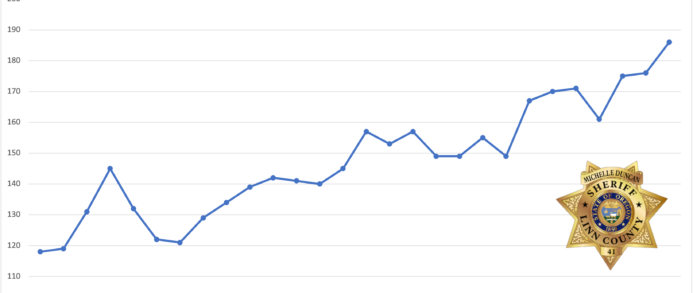 It has been my commitment since taking over as Sheriff in January to fully open the Linn County Jail. With that said, these decisions have to be made thoughtfully, considering staff safety, taxpayer dollars and the overall health and safety of the adults housed in our facility. With the help of some amazing staff working in our jail, we have been increasing the number of people we are holding in our facility every month and are very close to our normal capacity. We will continue to move our jail population numbers towards normal capacity. Yesterday, we had 186 adults in custody, and we are continuing to increase these numbers. Prior to COVID, in 2019, our average was 197, so we are very close.
It has been my commitment since taking over as Sheriff in January to fully open the Linn County Jail. With that said, these decisions have to be made thoughtfully, considering staff safety, taxpayer dollars and the overall health and safety of the adults housed in our facility. With the help of some amazing staff working in our jail, we have been increasing the number of people we are holding in our facility every month and are very close to our normal capacity. We will continue to move our jail population numbers towards normal capacity. Yesterday, we had 186 adults in custody, and we are continuing to increase these numbers. Prior to COVID, in 2019, our average was 197, so we are very close.
For the last two years, COVID has limited our capacity in the jail because of Oregon Health Authority (OHA) and the Centers for Disease Control (CDC) restrictions regarding social distancing, which for a time didn’t allow for inmates to be housed two to a cell; and quarantining of those in custody who were newly coming into the jail, tested positive for COVID or were a close contact with someone who did. Even today, although greatly relaxed from previous restrictions, correctional facilities are one of the few places where there are still some restrictions and direction because of COVID. The jail’s commitment was, and is, to do everything possible to safeguard the health of staff and the inmate population whom we are charged with care of. These restrictions must be followed to safeguard taxpayer dollars from potential lawsuits by those in custody who may contract COVID.
For the safety of those in our facility, including our staff, we still test everyone being lodged at the Linn County Jail. Those refusing testing (yes, they can do that) have a longer quarantine period than those complying with testing.
As the courts have been extremely slow on prosecutions for the last two years, we are housing some of these inmates much longer than normal, taking up some of our bed space. Currently, we have 16 people awaiting some kind of criminal homicide trial. Prior to COVID, we averaged 3-4 inmates on similar charges. These types of criminals are very dangerous and often have specific restrictions placed on them because of the severity of their crime. Having four to five times the number we normally house limits our ability to take in those committing lesser crimes. This is also true for other serious offenses, such as serious assaults, robberies, sex offenses and others. The Linn County Jail currently houses some of the worst of the worst.
The Linn County Jail has a maximum of 231 beds to house adults in custody, and I often get asked why we don’t have 231 people in custody at all times. This number is a maximum which is nearly impossible to ever meet because of the required separation of populations. Basically, we would have to have the perfect combination of inmate types to reach this capacity. We have several areas in the jail configured to house certain types of inmates. Most people realize males need to be separated from females. We have to separate high-risk offenders, who are a danger to others based on their behavior and/or charges, from the rest of the population. We cannot lodge these people in a cell with another inmate because they are also dangerous to each other. Separation based on gender and risk levels are just two examples of how we have always separated out the populations, affecting when and which bed space can be used. For example, if I have a block that has 20 beds when double-bunked (2 persons to a cell), and I have 8 high-risk offenders in that block that have to be single bunked (1 person to a cell), I have 12 beds that are left unused because by jail standards, I cannot place a lower risk inmate in the same block or cell with the high-risk, more dangerous, population.
Senate Bill 48 (SB48), which was passed earlier in the year and took effect July 1, has a direct influence on how much control we have on our population. Simply put, it mandates who we have to let out or keep with little regard to whether or not we have a bed for them. Once we have some time to truly evaluate the effects of SB48, I will reach out with a clearer perspective on jail operations under SB48 to keep our community informed.
I would like to thank our jail and medical staff who have worked tirelessly over the last couple of years with constant rule changes (by OHA and CDC) to best manage our population. Although, our population was lower for a time they have had additional work of testing, managing COVID outbreaks, managing a more dangerous population, rearranging our housing many times to maximize our capacity, and all while feeling the scrutiny of what they were doing when the jail could not take in people off the street, the way they did prior to COVID. They have worked hard to get us back to normal and maximizing the space we have. They serve a vital role in public safety.
It is important to let those out there committing crimes know we have a jail bed for you. I am proud of the corrections staff’s work on enabling us to do this (as much as the state law allows) to best protect our community. With their help, I am also looking to add double bunks to several more cells to increase as much as we can without compromising the safety of staff and inmates. The majority of our cells are already double bunks, but we will add where we can.
Linn County is a fantastic community and deserves to have criminals held accountable for their crimes. I am committed to this just as much as I was when I was a patrol deputy on the road making those arrests. I will look for every way possible to continue this mission at the Linn County Sheriff’s Office.
